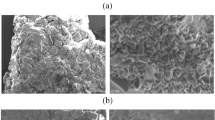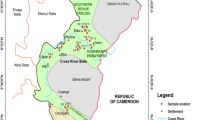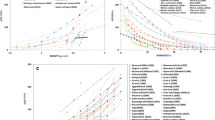Abstract
Quick and reliable estimation of intact rock strength parameters is vital for the excavation and stability measurement. The present research details the assessment of a few physico-mechanical parameters of sandstone rocks from Eastern India, and their statistical correlation and swift prediction. The dataset consists of 150 experimentally evaluated values for dry density, porosity, uniaxial compressive strength, tensile strength and Young’s modulus. Afterwards, the data were analyzed in the statistical environment “R” for correlation and distribution. For the ease of usage and implementation, density and porosity have been used as explanatory variables for the prediction of strength attributes. Initially, univariate linear regression models were devised, which yielded a coefficient of determination ranging between, 0.5 to 0.73. However, the r2 increased, in a range between 0.69 and 0.74, when multivariate analysis using the same independent variables was performed. In the present work, investigations and analysis have been done to predict the uniaxial compressive strength, tensile strength and Young’s modulus with dry density and porosity. Moreover, the statistical significance of the study has been discussed and compared with previous work. The present research can be used as a means to quickly and economically estimate strength parameters in the absence of a sophisticated testing setup.





Similar content being viewed by others

References
A. Ersoy, M.D. Waller, Textural characterization of rocks. Eng. Geol. 39, 123–136 (1995). https://doi.org/10.1016/0013-7952(95)00005-Z
A. Kainthola, P.K. Singh, D. Verma, R. Singh, K. Sarkar, T.N. Singh, Prediction of strength parameters of Himalayan rocks: a statistical and ANFIS approach. Geotech. Geol. Eng. 33, 1255–1278 (2015). https://doi.org/10.1007/s10706-015-9899-z
R. Singh, A. Kainthola, T.N. Singh, Estimation of elastic constant of rocks using an ANFIS approach. Appl. Soft Comput. 12, 40–45 (2012). https://doi.org/10.1016/j.asoc.2011.09.010
I.D.R. Bradford, J. Fuller, P.J. Thompson, T.R. Walsgrove, Benefits of assessing the solids production risk in a North Sea reservoir using elastoplastic modelling. SPE/ISRM Rock Mech. Pet. Eng. Soc. Pet. Eng. (1998). https://doi.org/10.2118/47360-MS
A. Tuğrul, I.H. Zarif, Correlation of mineralogical and textural characteristics with engineering properties of selected granitic rocks from Turkey. Eng. Geol. 51, 303–317 (1999). https://doi.org/10.1016/S0013-7952(98)00071-4
M.A. Rajabzadeh, Z. Moosavinasab, G. Rakhshandehroo, Effects of rock classes and porosity on the relation between uniaxial compressive strength and some rock properties for carbonate rocks. Rock Mech. Rock Eng. 45, 113–122 (2012). https://doi.org/10.1007/s00603-011-0169-y
A. Rahmouni, A. Boulanouar, M. Boukalouch, A. Samaouali, Y. Géraud, J. Sebbani, Porosity, permeability and bulk density of rocks and their relationships based on laboratory measurements. J Mater. Environ. Sci. 5, 931 (2014)
H. Awang, N.A.M. Naru, Predicting Uniaxial Compression Strength (UCS) Using Bulk Density for Kuala Lumpur Granite and Limestone. In: CIEC 2014, Springer, Singapore. pp. 557–566 (2015). https://doi.org/10.1007/978-981-287-290-6_49
K. Karaman, F. Cihangir, B. Ercikdi, A. Kesimal, S. Demirel, Utilization of the Brazilian test for estimating the uniaxial compressive strength and shear strength parameters. J. South Afr. Inst. Min. Metall. 115, 185–192 (2015)
G.R. Tripathy, S.K. Singh, Re–Os depositional age for black shales from the Kaimur Group, Upper Vindhyan. India. Chemical Geology 413, 63–72 (2015). https://doi.org/10.1016/j.chemgeo.2015.08.011
R. Prakash, I.K. Dalela, Stratigraphy of the Vindhyan in Uttar Pradesh: a brief review. In Geology of Vindhyanchal pp. 54–79 (1982).
M.A. Quasim, A.H.M. Ahmad, S.K. Ghosh, Depositional environment and tectono-provenance of Upper Kaimur Group sandstones, Son Valley, Central India. Arab. J. Geosci. 10, 4 (2017). https://doi.org/10.1007/s12517-016-2783-1
S. Sen, M. Mishra, Source rock composition of Kaimur Group siliciclastics from Vindhyan Supergroup, Central India: A response to thermal events associated with Bundelkhand Craton and Chhotanagpur Gneissic Complex at~ 1.1 Ga. Geol. J. 55, 4128–4158 (2020). https://doi.org/10.1002/gj.3613
R.J. Azmi, D. Joshi, B.N. Tiwari, M.N. Joshi, S.S. Srivastava, A synoptic view on the current discordant geo-and biochronological ages of the Vindhyan Supergroup central India. J. Himal. Geol. 29, 177–191 (2008)
I.S.R.M.: Suggested methods for Determining Water Content, Porosity, Density, Absorption and Related Properties and Swelling and Slake-Durability Index Properties (1977)
I.S.R.M. Suggested methods for Determining Tensile Strength of Rock Materials. ISRM Commission on Testing Methods (1978)
I.S.R.M. Suggested methods for Determining the Uniaxial Compressive Strength and Deformability of Rock Materials. ISRM Commission on Testing Methods (1979)
D.C. Montgomery, E.A. Peck, G.G. Vining, Introduction to linear regression analysis. John Wiley and Sons, Hoboken, pp. 20–40 (2012)
K.H. Zou, K. Tuncali, S.G. Silverman, Correlation and simple linear regression. Radiology 227, 617–628 (2003). https://doi.org/10.1148/radiol.2273011499
R Core Team: R. A. language and environment for statistical computing. R Foundation for Statistical Computing Vienna Austria URL (2020). https://www.R-project.org
K. Pearson, VII Note on regression and inheritance in the case of two parents. In: Proceedings of the Royal Society of London vol. 58, pp. 240–242 (1895). https://doi.org/10.1098/rspl.1895.0041
S.F. Anderson, Misinterpreting p: The discrepancy between p values and the probability the null hypothesis is true, the influence of multiple testing, and implications for the replication crisis. Psychol. Methods 25, 596–609 (2019). https://doi.org/10.1037/met0000248
F. Fidler, The American Psychological Association publication manual sixth edition: implications for statistics education. In: Proceedings of the Eighth International Conference on Teaching Statistics ICOTS8 (2010)
J. Miles, R squared, adjusted Rsquared. Wiley Statistics ReferenceOnline (2014). https://doi.org/10.1002/9781118445112.stat06627
D.S. Moore, W.I. Notz, M.A. Fligner, The Basic Practice of Statistics (Macmillan Higher Education, New York, 2012)
A.B. Hawkins, B.J. McConnell, Sensitivity of sandstone strength and deformability to changes in moisture content. Q. J. Eng. Geol.Hydrogeol. 25, 115–130 (1992). https://doi.org/10.1144/GSL.QJEG.1992.025.02.05
A.S. Gupta, K.S. Rao, Weathering effects on the strength and deformational behavior of crystalline rocks under uniaxial compression state. Eng. Geol. 56, 257–274 (2000). https://doi.org/10.1016/S0013-7952(99)00090-3
L.M. Sousa, L.M. del Río, L. Calleja, V.G. de Argandona, A.R. Rey, Influence of microfractures and porosity on the physico-mechanical properties and weathering of ornamental granites. Eng. Geol. 77, 153–168 (2005). https://doi.org/10.1016/j.enggeo.2004.10.001
Acknowledgements
The authors would like to thank the core team and myriad contributors of “The R Project for Statistical Computing” for their inestimable contribution.
Funding
None.
Author information
Authors and Affiliations
Corresponding author
Ethics declarations
Conflict of interest
The authors declared that they have no conflict of interest.
Additional information
Publisher's Note
Springer Nature remains neutral with regard to jurisdictional claims in published maps and institutional affiliations.
Rights and permissions
About this article
Cite this article
Chaudhary, V., Srivastav, A., Pandey, V.H.R. et al. Physico-Mechanical Characteristics of Vindhyan Sandstone, India. J. Inst. Eng. India Ser. D 103, 295–302 (2022). https://doi.org/10.1007/s40033-021-00301-1
Received:
Accepted:
Published:
Issue Date:
DOI: https://doi.org/10.1007/s40033-021-00301-1



